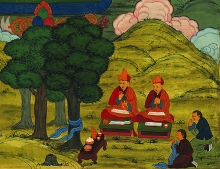Mongolian Buddhists and environmental protection
 |
 |
 |
Environmental and social justice activities are becoming
an important part of several monasteries' present activities and future plans.
|
The following information has been extracted from the
Mongolian Buddhists Protecting Nature Handbook which can be downloaded in English and in Mongolian.
The opportunity for environmental action by monasteries in Mongolia is much greater today than
it was in the early post-communist years. Then the main focus of monasteries was on
the physical reconstruction of temples and training of monks in theological practice.
But almost twenty years on, environmental and social justice activities are becoming
an important part of several monasteries' present activities and future plans.
“Over a period of 70 years, communism destroyed the foundations of Buddhism. Now
monks are trying to re-establish temples. The main focus at Gandan Monastery is
therefore on the construction of temples and on preparing human souls. We are now
establishing new targets in the environmental and social areas. These areas will be
developed more in the future,” said Da Lama Bayambajav of Gandan Monastery.
In 1999 the World Bank , ARC and WWF-Mongolia
started a project with Gandan
Monastery in Ulaanbaatar, which is the largest monastery in the country. The plan
was to rediscover some of the ancient sutras about sacred sites which had been
hidden during the communist purges, and translate them into modern Mongolian,
since so few people can read Tibetan any more.
The result was a powerful reminder for the monks, lay villagers, and many urban
Mongolians, most of whom had not realized the wide scale of the environmental
traditions in Mongolia and the extent of the number of sacred places. Many proved
to be important sites of bio-diversity, with forested areas that were critical for
maintaining the water table. Since 1999 six steles, or monumental stones, have been
erected again at some of the most important places around Ulaanbaatar, all of which
have once again been recognized as sacred. Link
here for an up to date list of the most sacred lands in Mongolia.
According to the former WWF-Mongolia Communication Officer Ms. B. Elbegzaya now at the International Centre for Mountain Development in Kathmandu : “The
monks did not at first realize their own huge potential to protect the environment”.
While they were already aware of many environmental practices, they had previously
considered these from a purely religious perspective. So for example, even while
Buddhism was banned during communist rule, people continued to respect ecologically
sound practices such as the taboos surrounding ovoo worship - but it took the input
of outside groups to show the monks the strength they already had in environmental
activism. “WWF made the first step along with ARC, working with monks. They saw
what was possible,” she said.
Another programme involved setting up an astrological nature calendar, inspired by
the traditional belief that nagas descend to earth on certain days every month and
throughout the year - and at those times the taboos against hunting, logging and
otherwise disturbing nature were said to be particularly strong. After the purges and
restrictions of the communist era some of the knowledge of this disappeared. At the
request of the monastic community a traditional astrological calendar was produced
by the monks of Gandan Monastery, in partnership with the World Bank, highlighting
the days when nagas descend. Although the return of the nagas varies according to
each tradition in Mongolian/Tibetan Buddhism, this calendar refers to the differences
when they occur, and is beginning to be widely recognised and used. Where tree
cutting or hunting are specifically forbidden on certain, more sacred, days, then
reminding people of these taboos would be likely to have a positive impact on nature
conservation.
Since Gandan Monastery took up the challenge, Erdene Zuu Monastery in
Karakorum has also become an environmental pioneer; as part of the monks' work
to prevent deforestation on the sparse mountainsides nearby they have initiated
projects to provide life skills for local children, help encourage alternative means
of income for poor families, and set up the beginnings of what is planned to be
a huge, forested, meditation garden, as described on the
case study page . Other monasteries to watch include Khamar Khiid in the East Gobi which has
a reforestation program; Ontsar Isei Lin Monastery in Baganuur district which has
been providing environmental training to miners and assessing the impact of mining
activities in their area; Amarbayasgalant Monastery in the far North and the very
active Luvsandanzanjantsan Studies Centre in Bayankhongor District.
Pages about Mongolian Environmental Wisdom, taken from the Handbook.
The Mongolian Lord of Nature.
Sacred texts, places and ovoos.
Sacred sites
in Mongolia.
Traditional Environmental Law in Mongolia.
The work that the monks, in conjunction with ARC and the World Bank and others, are carrying out to rediscover the sutras about sacred land in Mongolia.
Do you want to support this?
For full contact and address details of Mongolian Buddhist Monasteries, please see page 57 of the
Handbook. And for details of local Development, Environmental and Educational NGOs, please visit pages 58-59 of the
Handbook.
Other links to Mongolian Buddhism and the Environment
Link here to access the news story about the launch of the Mongolian Buddhist Handbook.
Link
here to download the Mongolian Buddhist Handbook in English. (Please note this file is 1.15MB)
Link
here to download the Mongolian version of the Handbook.(A 2MB file.)
Link here to download the guide to the Mongolian Buddhists’ Eight Year Plan (this file is 4.13MB).
Link to Mongolian Case Studies.
And
here on how to make contact with the Sangha.
To download the A3 poster of a new thangka about Buddhists protecting Nature, link
here (5.61MB).
Brief History of Mongolian Buddhism.
Buddhism and the Environment.
Women in Buddhism in Mongolia.
Key Figures in Mongolian Buddhism.
Key Meetings in Mongolia.
Mongolian Buddhists and Development.
Mongolian Buddhists and Ecology.
Mongolian Buddhist Hunting Ban.
The Lost Sutras.
|

